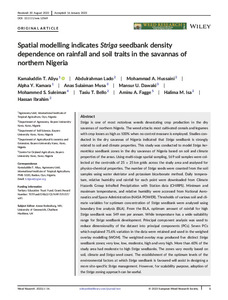| dc.contributor.author | Aliyu, K.T. |
| dc.contributor.author | Lado, A. |
| dc.contributor.author | Hussaini, M.A. |
| dc.contributor.author | Kamara, A. |
| dc.contributor.author | Musa, S.A. |
| dc.contributor.author | Dawaki, M.U. |
| dc.contributor.author | Suleiman, M.S. |
| dc.contributor.author | Bello, T.T. |
| dc.contributor.author | Fagge, A. |
| dc.contributor.author | Isa, H.M. |
| dc.contributor.author | Ibrahim, H. |
| dc.date.accessioned | 2023-02-17T13:02:05Z |
| dc.date.available | 2023-02-17T13:02:05Z |
| dc.date.issued | 2023-02-13 |
| dc.identifier.citation | Aliyu, K.T., Lado, A., Hussaini, M.A., Kamara, A., Musa, S.A., Dawaki, M.U., ... & Ibrahim, H. (2023). Spatial modelling indicates Striga seedbank density dependence on rainfall and soil traits in the savannas of northern Nigeria. Weed Research, 1-14. |
| dc.identifier.issn | 0043-1737 |
| dc.identifier.uri | https://hdl.handle.net/20.500.12478/8052 |
| dc.description.abstract | Striga is one of most notorious weeds devastating crop production in the dry savannas of northern Nigeria. The weed attacks most cultivated cereals and legumes with crop losses as high as 100% when no control measure is employed. Studies conducted in the dry savannas of Nigeria indicated that Striga seedbank is strongly related to soil and climate properties. This study was conducted to model Striga hermonthica seedbank zones in the dry savannas of Nigeria based on soil and climate properties of the areas. Using multi-stage spatial sampling, 169 soil samples were collected at the centroids of 25 25 km grids across the study area and analysed for physico-chemical properties. The number of Striga seeds were counted from the soil samples using water elutriator and potassium bicarbonate method. Daily temperature, relative humidity and rainfall for each point were downloaded from Climate Hazards Group InfraRed Precipitation with Station data (CHIRPS). Minimum and maximum temperatures, and relative humidity were accessed from National Aeronautics and Space Administration (NASA POWER). Thresholds of various soil and climate variables for optimum concentration of Striga seedbank were analysed using boundary line analysis (BLA). From the BLA, optimum amount of rainfall for high Striga seedbank was 549 mm per annum. While temperature has a wide suitability range for Striga seedbank development. Principal component analysis was used to reduce dimensionality of the dataset into principal components (PCs). Seven PCs which explained 75.6% variation in the data were retained and used in the weighed overlay modelling (WOM). The weighted overlay map produced five distinct Striga seedbank zones; very low, low, moderate, high and very high. More than 60% of the study area had moderate to high Striga seedbanks. The zones vary mostly based on soil, climate and Striga seed count. The establishment of the optimum levels of the environmental factors at which Striga seedbank is favoured will assist in designing a more site-specific Striga management. However, for scalability purpose, adoption of the Striga zoning approach can be useful. |
| dc.description.sponsorship | Tertiary Education Trust Fund |
| dc.format.extent | 1-14 |
| dc.language.iso | en |
| dc.subject | Striga |
| dc.subject | Modelling |
| dc.subject | Crop Production |
| dc.subject | Weeds |
| dc.subject | Climate Change |
| dc.subject | Food Security |
| dc.subject | Nigeria |
| dc.title | Spatial modelling indicates Striga seedbank density dependence on rainfall and soil traits in the savannas of northern Nigeria |
| dc.type | Journal Article |
| cg.contributor.crp | Grain Legumes |
| cg.contributor.crp | Maize |
| cg.contributor.affiliation | International Institute of Tropical Agriculture |
| cg.contributor.affiliation | Bayero University Kano |
| cg.coverage.region | Africa |
| cg.coverage.region | West Africa |
| cg.coverage.country | Nigeria |
| cg.coverage.hub | Headquarters and Western Africa Hub |
| cg.researchtheme | Plant Production and Health |
| cg.identifier.bibtexciteid | ALIYU:2023 |
| cg.isijournal | ISI Journal |
| cg.authorship.types | CGIAR and developing country institute |
| cg.iitasubject | Agronomy |
| cg.iitasubject | Climate Change |
| cg.iitasubject | Food Security |
| cg.iitasubject | Plant Breeding |
| cg.iitasubject | Plant Health |
| cg.iitasubject | Plant Production |
| cg.iitasubject | Weeds |
| cg.journal | Weed Research |
| cg.notes | Published online: 13 Feb 2023 |
| cg.accessibilitystatus | Limited Access |
| cg.reviewstatus | Peer Review |
| cg.usagerightslicense | Copyrighted; all rights reserved |
| cg.targetaudience | Scientists |
| cg.identifier.doi | https://dx.doi.org/10.1111/wre.12569 |
| cg.iitaauthor.identifier | kamaluddin tijjani: 0000-0003-1613-1147 |
| cg.iitaauthor.identifier | Alpha Kamara: 0000-0002-1844-2574 |
| cg.futureupdate.required | No |

